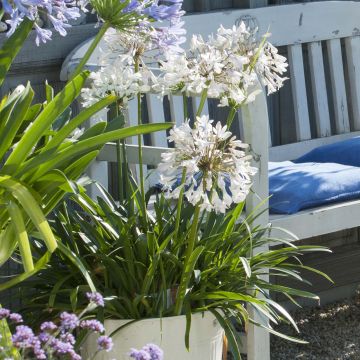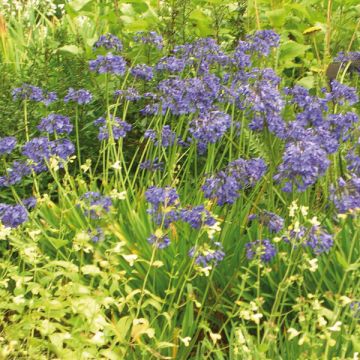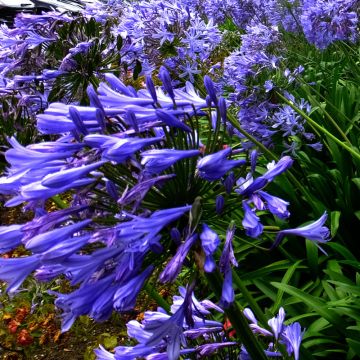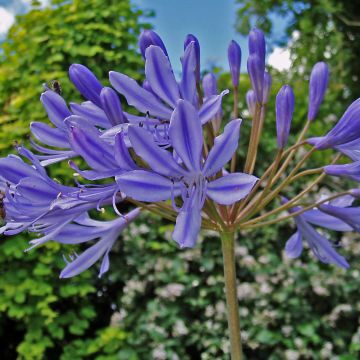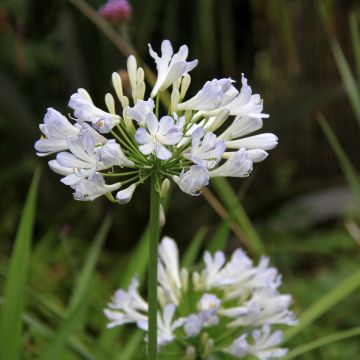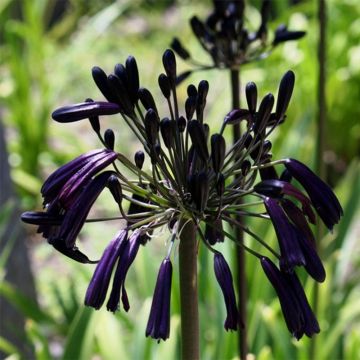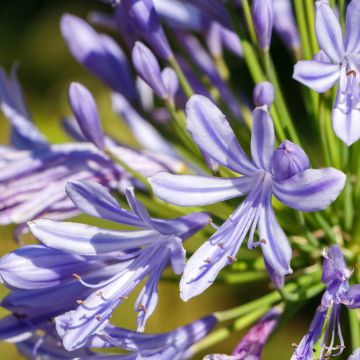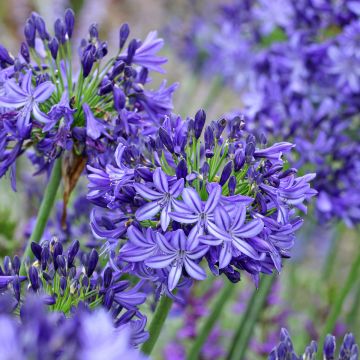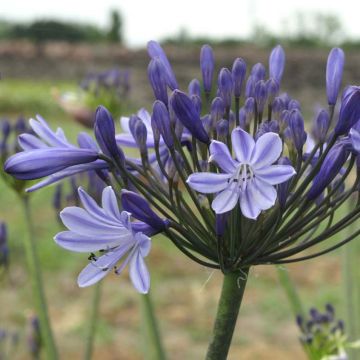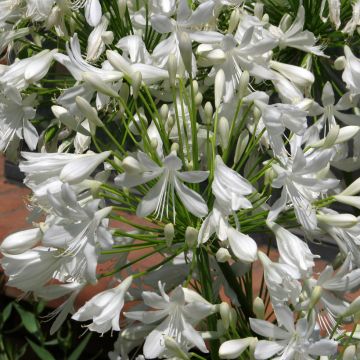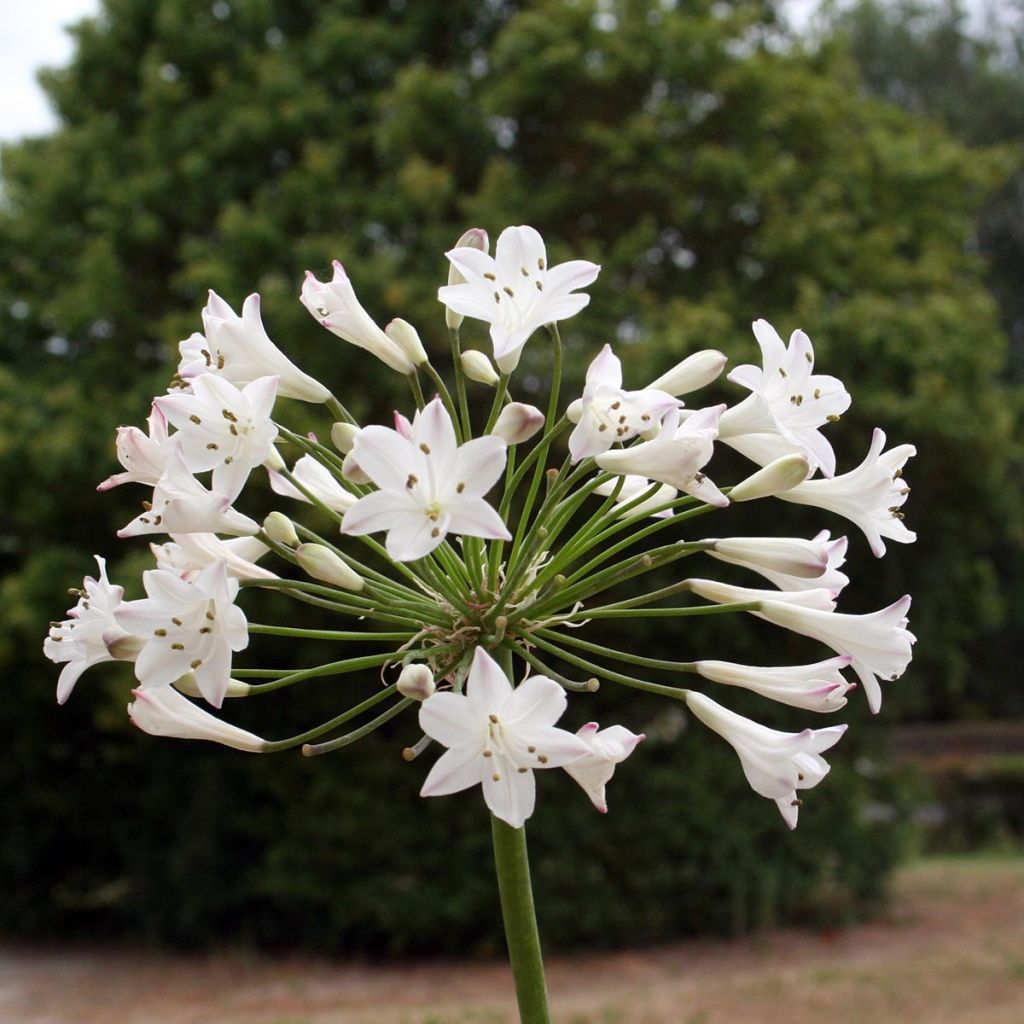

Agapanthus Glacier Stream
Agapanthus Glacier Stream
Agapanthus Glacier Stream
African Lily, Lily of the Nile
This item cannot be shipped to the selected country
Delivery charge from €5.90
Delivery charge from €5.90
More information
Schedule delivery date,
and select date in basket
This plant carries a 12 months recovery warranty
More information
We guarantee the quality of our plants for a full growing cycle, and will replace at our expense any plant that fails to recover under normal climatic and planting conditions.
From €5.90 for pickup delivery and €6.90 for home delivery
Express home delivery from €8.90.
From €5.90 for pickup delivery and €6.90 for home delivery
Express home delivery from €8.90.

Does this plant fit my garden?
Set up your Plantfit profile →
Description
Agapanthus 'Glacier Stream' is undoubtedly the first agapanthus that combines good cold resistance, vigorous growth with numerous floral stems approaching one metre in height, and a flowering where a touch of pink appears. Its flowers, white when they open, indeed become tinged with pink-mauve at the tips of the petals over the course of hours, while the floral stems darken. This magnificent flowering shows excellent resistance to bad weather. The cold resistance of this variety, up to -15°C when the plant is mature, allows it to be planted in the ground in many regions, provided that the soil is well-drained and the stump is protected by mulch in winter. This very different Agapanthus will undoubtedly surprise visitors, whether planted in a bed or in a flowering pot on the terrace.
Agapanthus plants belong to the lily family and are native to South Africa, where they naturally hybridize in nature or in our gardens. Agapanthus 'Glacier Stream' is a Dutch cultivar registered in 1995, recently introduced to the market. Note that this selection, in addition to its hardiness and original colour, is rather early and particularly floriferous.
This plant develops and multiplies rapidly from a stump with fleshy rhizomes, forming a dense tuft of linear, arched leaves, dark green and purplish at the base, at least 40cm (16in) in height and 45cm (18in) in diameter, expanding over time. The deciduous foliage disappears in winter. The abundant flowering takes place in summer, in July-August, more or less early depending on the climate, and lasts 4 to 5 weeks. Sturdy floral stems, about 90cm (35in) tall, bear at their tips umbels 12 to 15cm (5 to 6in) in diameter, composed of slightly drooping, bell-shaped flowers carried by long peduncles. The colour of the stems and peduncles gradually changes from green to purple-violet. Each white flower shows a fine median stripe of light violet, and the tips of the petals become pale pink-mauve. The stamens change from grey to almost black, creating an interesting contrast with the pastel flowers.
Agapanthus 'Glacier Stream' is an unusual and highly ornamental variety, to be adopted without hesitation in many regions, including in the ground. In a flower garden, it brings an exotic and light touch to the garden or terrace, while requiring little maintenance. Whether in a bed, border, rockery, pot, or container, the 'Glacier Stream' Agapanthus is suitable for a wide range of uses. It looks beautiful when associated with mauve, white, or blue Agapanthus in a minimalist setting. It is also very decorative in beds with an exotic theme, featuring lilies, Kniphofias, Hemerocallis, shrubby salvias, or Phlomis tuberosa. The flowers of this Agapanthus last a long time in a vase.
Report an error about the product description
Flowering
Foliage
Plant habit
Botanical data
Agapanthus
Glacier Stream
Alliaceae - Liliaceae
African Lily, Lily of the Nile
Cultivar or hybrid
Other Agapanthus - Lily of the Nile
Planting and care
Plant the stumps of 'Glacier Stream' Agapanthus by covering them with 8-10cm (3-4in) of good soil so that they withstand the cold better. It is preferable to install them in spring, but it is possible to plant them in early autumn in our regions benefiting from rather mild winters. Deciduous Agapanthus like a rich and well-drained soil, enriched with sand, that does not retain too much water in winter, but they prefer a soil that stays fresh throughout the growth and flowering period. Water them regularly during the growth period (twice a week) to help them establish. These plants fear excessive moisture in winter, combined with the cold. A good layer of straw, dead leaves or fern fronds will protect the stump from excessive moisture in winter.
Place them in a very sunny and sheltered position, even in partial shade in the south of our country. An annual compost addition in spring protects and nourishes the shallow roots, promoting extended flowering.
A well-drained sandy mixture, enriched with leaf compost, compost and garden soil, will be used. This plant seems to prefer shallow containers and will flower abundantly if regularly fed with slow-release fertilizer.
Planting period
Intended location
Care
-
, onOrder confirmed
Reply from on Promesse de fleurs
Haven't found what you were looking for?
Hardiness is the lowest winter temperature a plant can endure without suffering serious damage or even dying. However, hardiness is affected by location (a sheltered area, such as a patio), protection (winter cover) and soil type (hardiness is improved by well-drained soil).

Photo Sharing Terms & Conditions
In order to encourage gardeners to interact and share their experiences, Promesse de fleurs offers various media enabling content to be uploaded onto its Site - in particular via the ‘Photo sharing’ module.
The User agrees to refrain from:
- Posting any content that is illegal, prejudicial, insulting, racist, inciteful to hatred, revisionist, contrary to public decency, that infringes on privacy or on the privacy rights of third parties, in particular the publicity rights of persons and goods, intellectual property rights, or the right to privacy.
- Submitting content on behalf of a third party;
- Impersonate the identity of a third party and/or publish any personal information about a third party;
In general, the User undertakes to refrain from any unethical behaviour.
All Content (in particular text, comments, files, images, photos, videos, creative works, etc.), which may be subject to property or intellectual property rights, image or other private rights, shall remain the property of the User, subject to the limited rights granted by the terms of the licence granted by Promesse de fleurs as stated below. Users are at liberty to publish or not to publish such Content on the Site, notably via the ‘Photo Sharing’ facility, and accept that this Content shall be made public and freely accessible, notably on the Internet.
Users further acknowledge, undertake to have ,and guarantee that they hold all necessary rights and permissions to publish such material on the Site, in particular with regard to the legislation in force pertaining to any privacy, property, intellectual property, image, or contractual rights, or rights of any other nature. By publishing such Content on the Site, Users acknowledge accepting full liability as publishers of the Content within the meaning of the law, and grant Promesse de fleurs, free of charge, an inclusive, worldwide licence for the said Content for the entire duration of its publication, including all reproduction, representation, up/downloading, displaying, performing, transmission, and storage rights.
Users also grant permission for their name to be linked to the Content and accept that this link may not always be made available.
By engaging in posting material, Users consent to their Content becoming automatically accessible on the Internet, in particular on other sites and/or blogs and/or web pages of the Promesse de fleurs site, including in particular social pages and the Promesse de fleurs catalogue.
Users may secure the removal of entrusted content free of charge by issuing a simple request via our contact form.
The flowering period indicated on our website applies to countries and regions located in USDA zone 8 (France, the United Kingdom, Ireland, the Netherlands, etc.)
It will vary according to where you live:
- In zones 9 to 10 (Italy, Spain, Greece, etc.), flowering will occur about 2 to 4 weeks earlier.
- In zones 6 to 7 (Germany, Poland, Slovenia, and lower mountainous regions), flowering will be delayed by 2 to 3 weeks.
- In zone 5 (Central Europe, Scandinavia), blooming will be delayed by 3 to 5 weeks.
In temperate climates, pruning of spring-flowering shrubs (forsythia, spireas, etc.) should be done just after flowering.
Pruning of summer-flowering shrubs (Indian Lilac, Perovskia, etc.) can be done in winter or spring.
In cold regions as well as with frost-sensitive plants, avoid pruning too early when severe frosts may still occur.
The planting period indicated on our website applies to countries and regions located in USDA zone 8 (France, United Kingdom, Ireland, Netherlands).
It will vary according to where you live:
- In Mediterranean zones (Marseille, Madrid, Milan, etc.), autumn and winter are the best planting periods.
- In continental zones (Strasbourg, Munich, Vienna, etc.), delay planting by 2 to 3 weeks in spring and bring it forward by 2 to 4 weeks in autumn.
- In mountainous regions (the Alps, Pyrenees, Carpathians, etc.), it is best to plant in late spring (May-June) or late summer (August-September).
The harvesting period indicated on our website applies to countries and regions in USDA zone 8 (France, England, Ireland, the Netherlands).
In colder areas (Scandinavia, Poland, Austria...) fruit and vegetable harvests are likely to be delayed by 3-4 weeks.
In warmer areas (Italy, Spain, Greece, etc.), harvesting will probably take place earlier, depending on weather conditions.
The sowing periods indicated on our website apply to countries and regions within USDA Zone 8 (France, UK, Ireland, Netherlands).
In colder areas (Scandinavia, Poland, Austria...), delay any outdoor sowing by 3-4 weeks, or sow under glass.
In warmer climes (Italy, Spain, Greece, etc.), bring outdoor sowing forward by a few weeks.

































